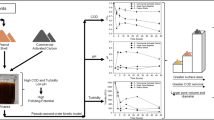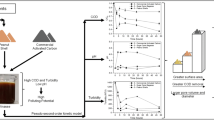Abstract
Four agricultural wastes, i.e., sugarcane bagasse, rice straw, cotton stalk, and corn stalk were experienced as low-cost lignocellulosic materials for their ability to adsorb reactive red dye from its contaminated solutions. Batch adsorption technology was carried out in order to analyze sorption behavior of dye-adsorbent systems at different wastes, initial dye concentration, and solution pH value. The acid pH treatment was detected to significantly enhance the adsorption efficiency of used lignocellulosic wastes to maximum removal efficiency (96%). Bioreactor technology was applied as up-scaling experiments using sugarcane bagasse (SCB) waste (the best adsorbent under batch experiments) with different adsorbent dosage and flow rates. The maximum removal efficiency (89.65%) was recorded by 448 g of SCB waste, hydraulic retention time of 24 h and 12.6 l/h flow rate. The SEM characterization illustrated accumulation of dye molecules onto lignocellulosic structure. Also, elemental analyses by EDAX instrument confirmed absorption technology. Thus, the sugarcane bagasse wastes can be applied as low-cost and environmental safe absorbent for RR dye removal from its contaminated wastewater and introducing non-traditional water resource.








Similar content being viewed by others
References
Abd El-Hady H (2014) Alternations in biochemical structures of phytoplankton in Aswan Reservoir and River Nile, Egypt. J Biol Environ Sci 4(2):68–80
Darwesh OM, Moawad H, Abd El-Rahim WM, Barakat OS, Sedik MZ (2014) Bioremediation of textile reactive blue (RB) azo dye residues in wastewater using experimental prototype bioreactor. Res J Pharm, Biol Chem Sci 5(4):1203–1219
Darwesh OM, Moawad H, Barakat OS, Abd El-Rahim WM (2015) Bioremediation of textile reactive blue azo dye residues using nanobiotechnology approaches. Res J Pharm, Biol Chem Sci 6(1):1202–1211
Eida MF, Darwesh OM, Matter IA (2018) Cultivation of oleaginous microalgae Scenedesmus obliquus on secondary treated municipal wastewater as growth medium for biodiesel production. J Ecol Eng 19(5):38–51. https://doi.org/10.12911/22998993/91274
Darwesh OM, Ali SS, Matter IA, Elsamahy T, Mahmoud YA (2020) Enzymes immobilization onto magnetic nanoparticles to improve industrial and environmental applications. Methods Enzymol, ISSN: 00766879 630:481–502. https://doi.org/10.1016/bs.mie.2019.11.006
Kheiralla ZH, Hewedy MA, Mohammed HR, Darwesh OM (2016) Isolation of pigment producing actinomycetes from rhizosphere soil and application it in textiles dyeing. Res J Pharm, Biol Chem Sci 7(5):2128–2136
Singh H, Chauhan G, Jain AK, Sharma SK (2017) Adsorptive potential of agricultural wastes for removal of dyes from aqueous solutions. J Environ Chem Eng 5(1):122–135. https://doi.org/10.1016/j.jece.2016.11.030
Tran HN, You SJ, Nguyen TV, Chao HP (2017) Insight into adsorption mechanism of cationic dye onto biosorbents derived from agricultural wastes. Chem Eng Commun 204(9):1020–1036. https://doi.org/10.1080/00986445.2017.1336090
Lafi R, Gzara L, Lajimi RH, Hafiane A (2018) Treatment of textile wastewater by a hybrid ultrafiltration/electrodialysis process. Chem Eng Process Process Intensif 132:105–113. https://doi.org/10.1016/j.cep.2018.08.010
Hasanin MS, Mostafa AM, Mwafy EA, Darwesh OM (2018) Eco-friendly cellulose nano fibers via first reported Egyptian Humicola fuscoatra Egyptia X4: isolation and characterization. Environ Nanotechnol Monit Manag 10:409–418. https://doi.org/10.1016/j.enmm.2018.10.004
Darwesh OM, El-Maraghy SH, Abdel-Rahman HM, Zaghloul RA (2020) Improvement of paper wastes conversion to bioethanol using novel cellulose degrading fungal isolate. Fuel 262:116518. https://doi.org/10.1016/j.fuel.2019.116518
Hasanin MS, Darwesh OM, Matter IA, El-Saied H (2019) Isolation and characterization of non-cellulolytic Aspergillus flavus EGYPTA5 exhibiting selective ligninolytic potential. Biocatal Agric Biotechnol 17:160–167. https://doi.org/10.1016/j.bcab.2018.11.012
Hasanin MS (2020) Sustainable hybrid silica extracted from rice husk with polyvinyl alcohol and nicotinic acid as multi adsorbent for textile wastewater treatment. Environ Sci Pollut Res 27:26742–26749. https://doi.org/10.1007/s11356-020-09104-5
Zhou Y, Zhang L, Cheng Z (2015) Removal of organic pollutants from aqueous solution using agricultural wastes: a review. J Mol Liq 212:739–762. https://doi.org/10.1016/j.molliq.2015.10.023
Youssef AM, Hasanin MS, Abd El-Aziz ME, Darwesh OM (2019) Green, economic, and partially biodegradable wood plastic composites via enzymatic surface modification of lignocellulosic fibers. Heliyon 5:e01332. https://doi.org/10.1016/j.heliyon.2019.e01332
Omo-Okoro PN, Daso AP, Okonkwo JO (2018) A review of the application of agricultural wastes as precursor materials for the adsorption of per-and polyfluoroalkyl substances: a focus on current approaches and methodologies. Environ Technol Innov 9:100–114. https://doi.org/10.1016/j.eti.2017.11.005
Temesgen F, Gabbiye N, Sahu O (2018) Biosorption of reactive red dye (RRD) on activated surface of banana and orange peels: economical alternative for textile effluent. Surf Interface 12:151–159. https://doi.org/10.1016/j.surfin.2018.04.007
Sangon S, Hunt AJ, Attard TM, Mengchang P, Ngernyen Y, Supanchaiyamat N (2018) Valorisation of waste rice straw for the production of highly effective carbon based adsorbents for dyes removal. J Clean Prod 172:1128–1139. https://doi.org/10.1016/j.jclepro.2017.10.210
Tahir H, Sultan M, Akhtar N, Hameed U, Abid T (2016) Application of natural and modified sugar cane bagasse for the removal of dye from aqueous solution. J Saudi Chem Soc 20:S115–S121. https://doi.org/10.1016/j.jscs.2012.09.007
Hasanin MS, Hashem AH, Abd El-Sayed ES et al (2020) Green ecofriendly bio-deinking of mixed office waste paper using various enzymes from Rhizopus microsporus AH3: efficiency and characteristics. Cellulose 27:4443–4453. https://doi.org/10.1007/s10570-020-03071-3
Darwesh OM, Matter IA, Eida MF (2019) Development of peroxidase enzyme immobilized magnetic nanoparticles for bioremediation of textile wastewater dye. J Environ Chem Eng 7(1):102805. https://doi.org/10.1016/j.jece.2018.11.049
Abdelhameed RM, El-Sayed HA, El-Shahat M, El-Sayed AA, Darwesh OM (2018) Novel triazolothiadiazole and triazolothiadiazine derivatives containing pyridine moiety: design, synthesis, bactericidal and fungicidal activities. Curr Bioact Compd 14(2):169–179. https://doi.org/10.2174/1573407213666170127095158
Abdelhameed RM, Darwesh OM, Rocha J, Silva AM (2019) IRMOF-3 biological activity enhancement by post-synthetic modification. Eur J Inorg Chem 2019:1243–1249. https://doi.org/10.1002/ejic.201801442
Gautam RK, Gautam PK, Banerjee S, Rawat V, Soni S, Sharma SK, Chattopadhyaya MC (2015) Removal of tartrazine by activated carbon biosorbents of Lantana camara: kinetics, equilibrium modelling and spectroscopic analysis. J Environ Chem Eng 3(1):79–88. https://doi.org/10.1016/j.jece.2014.11.026
Sultan YY, Ali MA, Darwesh OM, Embaby MA, Marrez DA (2016) Influence of nitrogen source in culture media on antimicrobial activity of Microcoleus lacustris and Oscillatoria rubescens. Res J Pharm, Biol Chem Sci 7(2):1444–1452
Hussein HA, Darwesh OM, Mekki BB (2019) Environmentally friendly nano-selenium to improve antioxidant system and growth of groundnut cultivars under sandy soil conditions. Biocatal Agric Biotechnol 18:101080. https://doi.org/10.1016/j.bcab.2019.101080
Halysh V, Sevastyanova O, Pikus S, Dobele G, Pasalskiy B, Gun’ko VM, Kartel M (2020) Sugarcane bagasse and straw as low-cost lignocellulosic sorbents for the removal of dyes and metal ions from water. Cell. 27:8181–8197. https://doi.org/10.1007/s10570-020-03339-8
Ibrahim S, Elsayed H, Hasnein M (2020) Biodegradable, antimicrobial and antioxidant biofilm for active packaging based on extracted gelatin and lignocelluloses biowastes. J Polym Environ. https://doi.org/10.1007/s10924-020-01893-7
Dehghani MH, Dehghan A, Najafpoor A (2017) Removing Reactive Red 120 and 196 using chitosan/zeolite composite from aqueous solutions: kinetics, isotherms, and process optimization. J Ind Eng Chem 51:185–195. https://doi.org/10.1016/j.jiec.2017.03.001
Dawood S, Sen TK (2012) Removal of anionic dye Congo red from aqueous solution by raw pine and acid-treated pine cone powder as adsorbent: equilibrium, thermodynamic, kinetics, mechanism and process design. Water Res 46(6):1933–1946. https://doi.org/10.1016/j.watres.2012.01.009
Fogel R, Garcia RR, da Suva Oliveira R, Palacio DNM, da Silva Madeira L, Pereira E (2005) Optimization of acid hydrolysis of sugarcane bagasse and investigations on its fermentability for the production of xylitol by Candida guilliermondii. 26th Symp Biotechnol Fuels Chem 741-752
Subramaniam R, Ponnusamy SK (2015) Novel adsorbent from agricultural waste (cashew NUT shell) for methylene blue dye removal: optimization by response surface methodology. Water Resour Ind 11:64–70. https://doi.org/10.1016/j.wri.2015.07.002
Wong SY, Tan YP, Abdullah AH, Ong ST (2009) The removal of basic and reactive dyes using quartenised sugar cane bagasse. J Phys Sci 20:59–74
Hassani A, Khataee A, Karaca S, Karaca M, Kıranşan M (2015) Adsorption of two cationic textile dyes from water with modified nanoclay: a comparative study by using central composite design. J Environ Chem Eng 3(4):2738–2749. https://doi.org/10.1016/j.jece.2015.09.014
Bhatti HN, Sadaf S, Aleem A (2015) Treatment of textile effluents by low cost agricultural wastes: Batch biosorption study. J Anim Plant Sci 25(1):284–289
El-Bindary AA, El-Sonbati AZ, Al-Sarawy AA, Mohamed KS, Farid MA (2014) Adsorption and thermodynamic studies of hazardous azocoumarin dye from an aqueous solution onto low cost rice straw based carbons. J Mol Liq 199:71–78. https://doi.org/10.1016/j.molliq.2014.08.010
Khodabandehloo A, Rahbar-Kelishami A, Shayesteh H (2017) Methylene blue removal using Salix babylonica (Weeping willow) leaves powder as a low-cost biosorbent in batch mode: kinetic, equilibrium, and thermodynamic studies. J Mol Liq 244:540–548. https://doi.org/10.1016/j.molliq.2017.08.108
Laskar N, Kumar U (2017) SEM, FTIR and EDAX studies for the removal of safranin dye from water bodies using modified biomaterial-Bambusa tulda. In IOP Conference Series: Mat Sci Engin 225(1): 012105 IOP Publishing
Baruah S, Devi A, Bhattacharyya KG, Sarma A (2017) Developing a biosorbent from Aegle marmelos leaves for removal of methylene blue from water. Int J Environ Sci Technol 14(2):341–352. https://doi.org/10.1007/s13762-016-1150-9
Acknowledgments
The authors would like to express their thanks to the National Research Centre and Faculty of Agriculture, Cairo University, for their support this work.
Author information
Authors and Affiliations
Corresponding author
Additional information
Publisher’s Note
Springer Nature remains neutral with regard to jurisdictional claims in published maps and institutional affiliations.
Rights and permissions
About this article
Cite this article
Darwesh, O.M., Abd El-Latief, A.H., Abuarab, M.E. et al. Enhancing the efficiency of some agricultural wastes as low-cost absorbents to remove textile dyes from their contaminated solutions. Biomass Conv. Bioref. 13, 1241–1250 (2023). https://doi.org/10.1007/s13399-020-01142-w
Received:
Revised:
Accepted:
Published:
Issue Date:
DOI: https://doi.org/10.1007/s13399-020-01142-w




